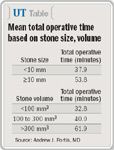Article
Larger stone volume equals more work, similar outcomes
Author(s):
Cleveland-The size and volume of upper-urinary-tract calculi do not necessarily predict outcomes of ureteroscopic lithotripsy, but stones of larger size and volume require significantly more time and effort to clear, according to a group of urologists from St. Paul, MN.

Stone volume was more sensitive than stone size, although both factors were predictive of the amount of overall work involved for the surgeon.
"The stone is not a javelin; it's more like a soccer ball," Andrew Portis, MD, medical director of the HealthEast Kidney Stone Institute, told colleagues at the World Congress of Endourology here. "A 10-mm by 5-mm stone is a lot different from a 10-mm by 10-mm stone. The 10×10 stone is going to be a longer day at the beach for the urologist, and it may be a stone you want to reserve for a time when you have gained more experience."
"We've been using these one-dimensional measurements for 20 years now, and they're meaningless," Dr. Dretler said.
Dr. Portis and his group from Metropolitan Urologic Specialists and HealthEast Kidney Stone Institute culled their data from a previously published paper (J Urol 2006; 175:2129-34). That study confirmed the efficacy of the group's "active fragment extraction" technique following ureteroscopic laser lithotripsy. The technique entails meticulous control over stones and fragments, with the intent to remove all debris from the kidney. In the technique, patients are positioned in a low lithotomy Trendelenburg position to encourage stone fragments to gather in easily accessible parts of the kidney.
A total of 69 patients with three or fewer upper-tract calculi were involved in the original study, with each stone ranging from 5 to 15 mm on preoperative CT. Postoperative imaging was performed at 1 month.
Categorized by size, volume
In the current study, patients were categorized by stone size (where sum of maximal dimensions <10 mm was considered "small" and ≥10 mm was designated "large") and stone volume (with <100 mm3 categorized as "small," 100 to 300 mm3 "medium," and >300 mm3 "large").
The investigators found that ureteroscopic passes, laser time, basket time, and total operative time were all significantly higher in larger stones versus smaller ones. Similarly, those factors were all comparable in small-and medium-volume stones, but went up noticeably in large-volume calculi.
"As we continue this work, it may provide a basis for deciding at what point a stone is too big to treat if you have, say, a frail patient who you wouldn't want to undergo a longer procedure," said Dr. Portis, medical director, HealthEast Kidney Stone Institute. "It provides a good basis to identify the easy or more straightforward cases where you can refine your technique and then move on to more difficult stones."
Stone size-specific success rates were similar at fragment thresholds of 0 mm (60% for small stones, 48% for large stones), 2 mm (89% and 76%, respectively), and 4 mm (94% and 95%, respectively). Stone volume-specific success rates were similar at those same fragment thresholds of 0 mm (57% for small-volume, 63% for medium-volume, 44% for large-volume), 2 mm (95%, 84%, and 69%, respectively), and 4 mm (100%, 90%, and 94%, respectively).















